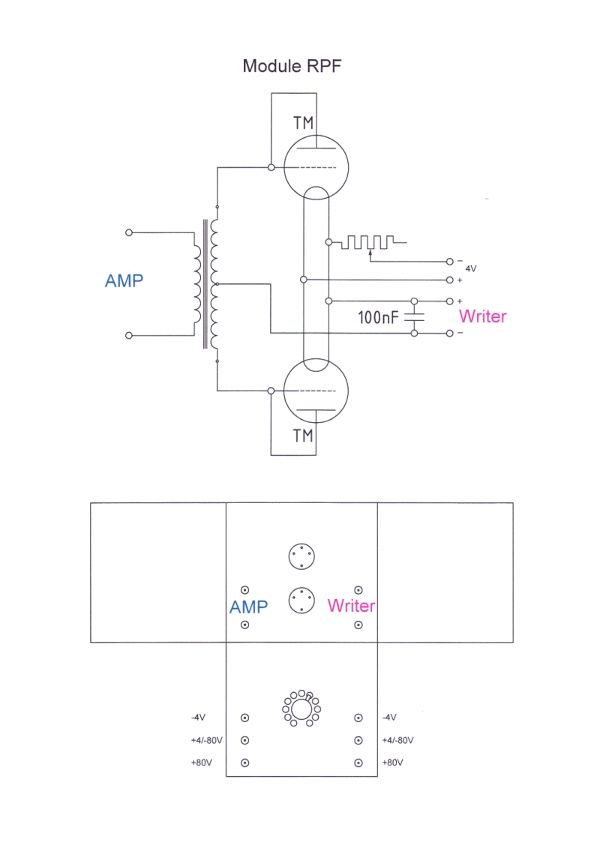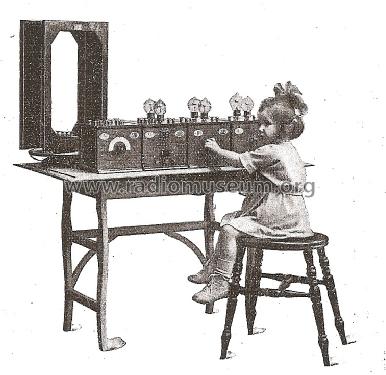Radio-Puzzle RPF
SBR Société Belge Radio-Electrique, Bruxelles
- País
- Bélgica
- Fabricante / Marca
- SBR Société Belge Radio-Electrique, Bruxelles
- Año
- 1922

- Categoría
- Módulo de radio de antes de 1926 (ni parte ni manipulador)
- Radiomuseum.org ID
- 228393
Haga clic en la miniatura esquemática para solicitarlo como documento gratuito.
- Numero de valvulas
- 2
- Principio principal
- Detector de tubo (sin "tuner")
- Gama de ondas
- - no hay
- Especialidades
- Converter
- Tensión de funcionamiento
- Baterías recargables o pilas / 4 Volt
- Altavoz
- - - No hay salida de sonido.
- Material
- Madera
- de Radiomuseum.org
- Modelo: Radio-Puzzle RPF - SBR Société Belge Radio-
- Forma
- Sobremesa, caja, normalmente con tapa (panel no inclinado).
- Ancho, altura, profundidad
- 190 x 190 x 200 mm / 7.5 x 7.5 x 7.9 inch
- Anotaciones
-
- This unit is part of the so-called "Radio-Puzzle" which is modular in conception by placing every stage in a different module. It could be configured not only as a radio with different principles but also as telegraphy receiver and writer or as measuring equipment.
- By combination of different units, one gets a complete radio or other application.
- All connections are made with wires in clamping screws.
- The clamping screws for the filament "A" battery and the plate voltage "B" battery are placed at the same height/depth so that they can be easily interconnected. The whole powerline setup is made as a daisy chain.
- These units were initially manufactured and commercialised by S.I.B. from 1920 on before SBR took over the retailing under their own label in 1922.
- Used coils on these units are Disco-self 1922 or the preceding SIB Disco-Self 1920. They are optionally mounted on the side panels of units A, B and E. The obtainable frequency range with those coils was approximately 13kHz (23000m) to 1,75MHz (170m).
- The following modules of the Radio-Puzzle are known:
- RPA = Tuning module and optionally a crystal detector. Despite the fact that this unit doesn't need power, it has power connectors to pass along the current to the next unit;
- RPB = Tuning module with RF amplifier and detector;
- RPC = RF amplifier with regenerative feedback or an autodyne with a "Compensateur"1 and optionally a detector;
- RPD = RF amplifer with RC2 interstage coupling (autodyne amplifier together with RPC). However, this unit can be used as LF amplifier stage also;
- RPE = LF amplifier with interstage transformers;
- RPF = Tube detector (not an amplifier) to drive a morse writer or a repeater morse key. Driving power for the following relais after this unit comes from the preceding LF amplifier module (see schematic and explanation at the bottom of this page);
- RPG = Variable coupling unit for 2 disco-self coils from which 1 has fixed position on the preceding unit RPA, RPB;
- RPR = Variable coupling unit for 3 disco-self coils from which 1 has fixed position. It could be used to make a regenerative circuit by variable induction.
Alternative for TM tubes: Marconi_R
1 Compensateur: the differential variable capacitor to control the positive and negative feedback. Not a butterfly capacitor.
2 Resistor and capacitor.
- Precio durante el primer año
- 203.00 BFr
- Autor
- Modelo creado por Dirk Bladt. Ver en "Modificar Ficha" los participantes posteriores.
- Otros modelos
-
Donde encontrará 735 modelos, 682 con imágenes y 418 con esquemas.
Ir al listado general de SBR Société Belge Radio-Electrique, Bruxelles
Contribuciones en el Foro acerca de este modelo: SBR Société Belge: Radio-Puzzle RPF
Hilos: 1 | Mensajes: 1
Morse code pulsating tones enter the RPF (AMP), are rectified and result in a pulsating DC voltage (Writer).
This output signal may drive a relay with a pen for writing down the morse code or a relay with a morse key to convey the code (repeater key).
The power to the relay following the RPF module is provided by the preceding LF amplifier (RPE module).
Module RPF does not need a DC anode voltage supply. With the grids attached to the anodes, the tubes act as diodes and rectify the signal delivered to the anodes.
See schematic with waveform example below.


Dirk Bladt, 20.Feb.13

